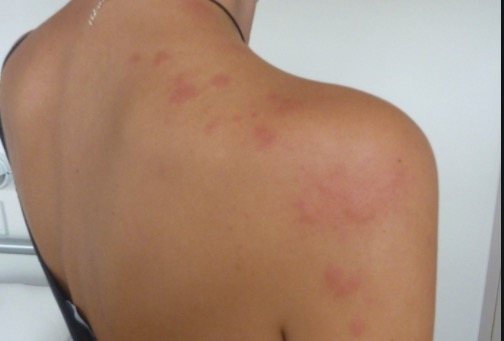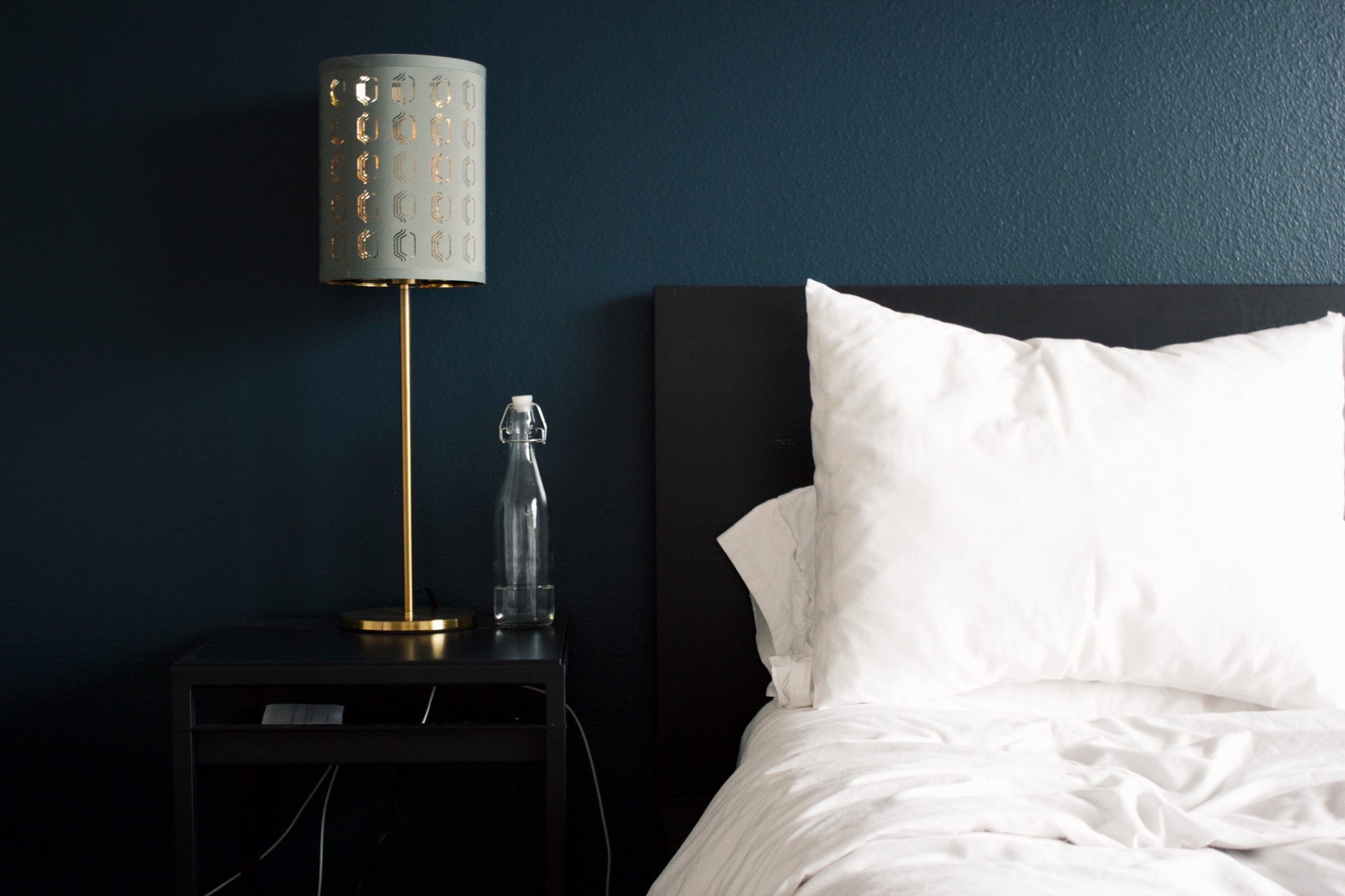Bed bugs are common pests that have been around for decades.
Appearing in places like:
- Homes
- Schools
- College dorms
- Shelters
- And more…
This is leaving people desperate for ways to get rid of bed bugs for good and stop them from spreading.
Since these creatures are difficult to exterminate…
It’s critical to understand them and how they reproduce.
In this article, we run through everything you need to know about bed bugs and their eggs.
Including:
What do their eggs look like?
Where are bed bug eggs found?
How do you get rid of them?
And more.
On that note… Let’s dive in.
Page Contents:
Bed Bug Eggs
A female bed bug can begin laying eggs 3 days after her first meal.
And as long as the female has a consistent feeding source…
She will lay on average from 3 to 8 eggs per week.
The most fertile female bed bugs will lay up to 12 eggs per day.
This is why if you’re exposed to bed bugs when traveling, it’s very easy to bring an infestation home with you.
If even one female bed bug rides home in your luggage or belongings, you can have a full-on infestation in your home in a matter of months.
Though bed bugs reproduce quickly, they need stable environmental conditions for their eggs to hatch successfully.
This is why eggs are laid in places with minimal disturbance.
Such as:
- Behind furniture
- Cracks in walls
- Along baseboards
- Within folds of the mattress
These eggs have a special adhesive that allow them to stay in place at all times.
Hatched Bed Bug Eggs
Bed bug eggs will hatch within 5 to 16 days of being laid.
After they hatch, the baby bed bugs…
(otherwise known as nymphs).
Will start looking for a host to feed on immediately.
Though an adult bed bug can go up to 1 year without being fed, nymphs need to feed at least once per week to successfully mature into an adult.
The lifespan of a typical bed bug is around 18 months, though there are several environmental factors that can alter this range.
Most bed bugs can produce 3 generations in one year.
This is why it’s critical to take action on a suspected bed bug case IMMEDIATELY. The more you allow bed bugs to spread, the harder and more expensive they are to remove.

How Do Bed Bugs Reproduce?
Male and female bed bugs have sex through a process called traumatic insemination.
(As the name implies, it isn’t a pleasant experience… for the female at least.)
The male bed bug will “stab” the female bed bug in the abdomen with their “aedeagus”, which is the insect equivalent to mammalian genitalia.
The male gametes (sperm cells) travel to female gametes (ovaries), and this is how fertilization takes place.
Once fertilization happens, a female bed bug can carry eggs for 5 to 7 weeks.
These bugs need a stable environment and consistent food source in order to reproduce properly.
For example…
In an environment that is too cold (55 degrees F or lower):
Bed bugs will enter diapause, a period of dormancy similar to hibernation. In this state bed bugs do not develop, barely move, and do not reproduce.
In an environment that is too hot (120 degrees F or higher):
Bed bugs will die in a matter of hours. One of the most effective bed bug treatment methods is a professional heat treatment, which raises the temperature of an infested area for several hours until ALL of the insects are dead.
What Do Bed Bug Eggs Look Like?
Bed bug eggs look like little white dots. Their color will vary from fully transparent to pearl white depending on how close the egg is to being hatched.
Bed bug eggs are only 1 mm in length so it can be difficult to see a single egg with the human eye.
They are most commonly found in clusters, sticking to wooden or fabric surfaces.
(They are less commonly found on plastic or metal).
Fresh bed bug eggs will be more transparent but also shiny due to the sticky substance that is secreted immediately after the female bed bug reproduces.
If the egg doesn’t stick to the surface it’s laid on…
It’s less likely the egg will hatch successfully.
Bed Bug Eggs Pictures
Below are a couple of images that show what bed bug eggs look like.

In the photo above you can see a mixture of bed bug eggs that are soon to hatch, along with nymphs and adults. On the bottom right of the image you see a couple of shed exoskeletons as well. 
The above photo shows a view of what an infestation looks like on a mattress to the naked eye. You can see a mixture of bed bug droppings (little black dots) along with some shed skin (tan/brown smudges).

The above photo is an extreme close-up of what a bed bug egg looks like. You can see they’re almost completely see-through, which is why they’re difficult to spot without a magnifying glass.
Bed Bug Egg Shells
It can be difficult to decipher an egg before vs. after it’s hatched. The only difference is that an empty eggshell won’t be shiny, and can appear more flattened.
If you do happen to come across a collection of empty eggshells…
This is strong evidence of an existing infestation.
Other similar evidence may include:
- A collection of molted or shed skin.
- Red spots on the mattress or box spring (indicating blood spots).
- Brown/black spots on the mattress (indicating bed bug droppings).
Of course, the best evidence of an infestation is live bed bugs or bed bug bites on your skin.

You should always check for bed bug evidence before you spend the night in a new residence.
Whether it be an apartment or hotel room…
No place is immune to an infestation.
If you suspect bed bugs in one of these places, you should report the infestation immediately to property management.
Where Do Bed Bugs Lay Eggs?
Bed bugs will lay their eggs in areas where infestations are most commonly found. They prefer hiding, laying their eggs, and feeding all within a 20-foot radius. This is why similar to active bed bugs, their eggs are commonly found in the bedroom.
Bed bugs cannot travel very far on their own…
(They can only crawl 3 to 4 feet per minute).
This is why bed bugs rely on “hitchhiking” to do much of their traveling and spreading.
Bed bugs can hitchhike on your:
- Luggage
- Handbags
- Clothes
- Boxes
- Sometimes places on your body

Within the bedroom bed bugs will lay their eggs where they can’t easily be seen. This includes around the bed frame, or within folds of the mattress.
Though to stop bed bugs from hiding within your mattress…
Consider getting a special bed bug mattress encasement to make it more difficult for bed bugs to lay eggs and spread.
Do Bed Bugs Lay Eggs on Humans?
Bed bugs will not lay eggs on humans. These creatures prefer to lay their eggs in a stable area that is most likely to be left undisturbed. The preference of residing near the host is conditional upon the ability for the eggs to survive all the way up until they hatch.
Theoretically, if a bed bug were to lay an egg on you it would likely not survive.
What about in the case of severe infestations?
In a severe infestation bed bugs WILL go outside of their normal hiding places within the bedroom to lay their eggs.
This is because overcrowding will start to occur, so bed bugs will need to spread out.
Even so:
They will prefer to stay within 5 to 10 feet of the bed. Therefore, they will choose hiding places such as:
- The carpet
- Neighboring walls
- Within drawers
- Around piles of clothes
- Within electric sockets
- Kitchen Appliances

These pests are quite nimble, and their flat bodies can allow them to create a home out of the hardest to reach places.
This includes places that are only as thick as an index card.
Bed Bug Eggs in Hair
Since bed bugs can theoretically reside almost anywhere, we can’t rule out the fact that bed bugs can be found in your hair.
Though these insects are not nearly as adept to live on your head or navigate around your hair like Lice can.
If you do have bed bug eggs in your hair, you may notice a musty odor coming from your head, as well as bloodstains on your pillow.
So How Do You Remove Bed Bugs From Your Head?
Washing your hair with hot water can help loosen bed bugs or their eggs caught within your hair.
Do Bed Bug Eggs Move?
Luckily bed bug eggs do not move. They stay put and out of sight as they are 1mm in length and off-white in color. They take between 6 and 10 days to grow and hatch.
So, if you have bed bugs you’ll start to see their numbers increase after about a week.
Though if you’re still reading this article bed bugs are probably lurking around your bed right now…
So How Do They Spread So Fast?
Female bed bugs typically lay between 1 and 6 eggs per day. While the eggs don’t move, they are produced extremely quickly so it may appear like they’re moving all around you.
The eggs are also sticky so they stay in place as long as they aren’t disturbed.
If you notice your clothes or linens are riddled with bed bug eggs you may just want to throw them away rather than try and salvage them.
(We wouldn’t blame you).
How Do You Kill Bed Bug Eggs?
There are many methods that can kill bed bugs and their eggs. Whether it be through a professional heat treatment or DIY treatment such as diatomaceous earth, the degree of effectiveness will depend on the severity of the infestation.
It’s critical that when you treat a bed bug infestation, you eradicate bed bugs in ALL life stages.
In cases where the people in your household are receiving bites every night…
You should resort to a professional treatment method.
If you have only noticed a couple of bugs here and there, you can try the most effective DIY methods.
When determining a treatment method you should do your research.
Why?
Because these creatures are some of the hardest household pests to kill.
The wrong treatment method will waste time and can extend this nightmare of a problem to months (if not years).
Bed bugs have also grown an increasing amount of resiliency to pesticides, so it’s important to understand what insecticides do/don’t work, and which ones are safe to use indoors.
The EPA came out with a list of over 300 approved bed bug control products that can be used as a reference.
What Kills Bed Bugs and Their Eggs?
The best methods to kill bed bugs and their eggs include heat treatments, insecticide sprays, diatomaceous earth, vacuuming, and removing clutter. Some of the more effective methods can be costly and cause greater disruption to your everyday living, but they may be necessary to permanently remove bed bugs from your life.
Let’s go into detail about these methods below:
Heat Treatments:
Professionals will bring industrial-sized heaters into your home, in order to raise the temperature for several hours. This treatment is extremely effective but can also be expensive.
(upwards of $5,000 depending on the size of your home).
Benefits of the heat treatment include:
- It will penetrate bed bugs in hard to reach places.
- Typically only requires 1 treatment to remove an ENTIRE infestation.
- It is healthier and more environmentally friendly.

If you’re experiencing a large-scale infestation, the heat treatment is the most recommended method of removal.
Insecticide Treatment (Conventional Method):
A professional will come to your home and spray insecticides around the infested areas. This method is typically cheaper, and more discrete over a heat treatment.
Pesticides have been used for decades to kill bed bugs, so it’s a proven treatment that does work over time.
Some of the disadvantages include:
- It requires multiple treatments.
- It may not hit bed bugs that are hiding in hard to reach places.
- It’s not always safe to spray pesticides in areas that you sleep.
Diatomaceous Earth:
This product can be used as one of many DIY methods to kill bed bugs. It’s a powdery substance that can be applied to carpets, baseboards etc. that will dry out bed bugs and kill them within 2 to 3 days after exposure.
Unlike sprays, this product does need to be removed at some point, as it doesn’t disappear on its own.

At the end of the day this product is very popular, because it’s inexpensive and still considered effective.
Click here for everything you need to know about Diatomaceous Earth.
Vacuuming & Removing Clutter:
Vacuuming and cleaning are important, but will not remove an infestation if not paired with one of the above methods.
Vacuuming is an effective method that’s easy to do and can remove bed bugs in main areas of your home.
(Especially active bed bugs that are not currently in hiding).
Removing clutter is very important for the identification and discovery of an infestation.
The first step toward removing bed bugs is early detection, and then diagnosis over similar insects.
The earlier you see an infestation, the earlier you can take appropriate action for removal before it has a chance to spread.
Conclusion
Bed bugs are not the kind of pests you want in your home. Honestly, you don’t want any pests in your home! If you encounter bed bugs, the eggs themselves are a very important piece of the removal puzzle.
The more eggs, the more bugs, the more bugs, the bigger the infestation.
(You get the idea).
We hope that everything goes well with your treatment plan, and remember bed bug eggs don’t move…
They multiply!







Very very interesting. Can I use that graphic related to the temperatures that bed bugs cannot survive? I’m a property manager and I’m trying to educate my staff about what temperatures kill bed bugs… let me know!!!
I wanted to learn more about irradicating the eggs.
As for the person who asked about the heat method; to be safe, an entire space must reach over 350 degrees for at least 3 hours to kill them. It is best to let a pro do it. Things can melt or be destroyed if proper procedures are not followed.